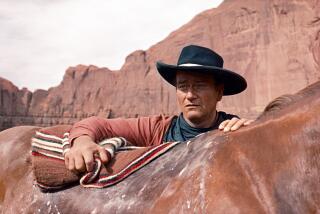Drawing on his comic book cred
Rob McCallum holds the rare distinction of having once drawn 300 storyboards -- the comic-book-like panels that summarize a film’s shots for the crew -- in 72 hours. “And then a couple of days later they go, ‘Hey, we’ve changed things. You think you could it again?’ ” says McCallum with a laugh. While most jobs aren’t quite so Proustian in their page count, McCallum spends the majority of most of his days drawing. He works off scripts, shot lists and brainstorming sessions with directors and key crew.
Born in the Scottish town of Greenock, McCallum grew up on a steady diet of “Star Wars” and Ray Harryhausen movies before heading to the Glasgow School of Art. He dabbled in directing short films before landing a job drawing comics for the likes of Marvel, DC and Dark Horse. In the late 1990s, a day after learning that the project he’d been working on -- Stan Lee’s “Excelsior Line” -- had been put on indefinite hold due to Marvel’s business woes, he got a call to do storyboards on a Hallmark film in Scotland and hasn’t looked back since.
Recently, the Toronto-based McCallum put pencil to paper for Doug Liman’s teleportation thriller “Jumper,” due for release Thursday, and the high-school dramedy “Charlie Bartlett,” which hits theaters Feb. 22.
Comic relief: Since storyboards are a communication tool for directors to convey their vision to the crew, McCallum strives to make his as interesting as possible. “I try to make my storyboards a good read when I’m drawing,” says the artist, who has worked on films including “Land of the Dead,” “Hairspray” and “Mr. Magorium’s Wonder Emporium.” “I think it may be from when I drew comics. There’s a pacing in comics, and you’re always aware of the person turning the page. You know, a really big moment in the comic, you’ll turn the page and it’ll be a big double-page splash panel for full impact. And I still try and do that sometimes. I will give expressions to people’s faces. I will put in a wee bit of extra detail here and there just to sell the sequence. I try and make it so that you get a sense of the speed and the mood and the emotion of each sequence from my boards.”
Without breaking a sweat: Storyboard artists such as McCallum usually only draw the most expensive and logistically intricate scenes involving action, visual effects and special effects such as fire and explosives, gun shots and the like. On “Charlie Bartlett,” the most complicated sequences were a riot and a football game, both of which may have ended up on the cutting room floor. “I just remember the day they were shooting the football game, it was an utter heat wave in Toronto,” he says. “And they’ve got all these extras running about playing football with all the gear on and stuff, and I felt for them because I’m sitting here in this air-conditioned office just drawing!”
Jumping-off place: While most projects have one storyboard artist, “Jumper” had upward of a half-dozen, each of whom concentrated on a different action sequence. “I had the coliseum sequence to do,” says McCallum. “I actually had a 3-D model in my computer of the coliseum that had been built, and I was able to get the camera down there and move it around and just pick out shots and cool angles and stuff. It’s handy having that.”
Foul is fair: To ensure their drawings reflected the laws of “Jumper’s” sci-fi universe, the storyboard artists were given a set of rules governing teleportation. “It was forcing you to think in a slightly different way,” says McCallum. “I was just thinking, ‘How would a guy that can teleport fight?’ So you were really pushing yourself to try to think of inventive, cool, spectacular ways that you could use this jumping talent that these characters have.”
Senseless census: Storyboards can sometimes be taken too literally. “I was on a film once where someone was counting the heads of people in crowd scenes I’d drawn to know how many extras to hire,” says McCallum. “I was stunned when I heard that. I was just randomly drawing people to fill up the panels. There’s a guy I know who actually puts a disclaimer on the front page of his storyboards saying that these are a guide. Costumes may not look like this. Hairstyles may not look like this. These aren’t like the Bible!”
More to Read
Only good movies
Get the Indie Focus newsletter, Mark Olsen's weekly guide to the world of cinema.
You may occasionally receive promotional content from the Los Angeles Times.






